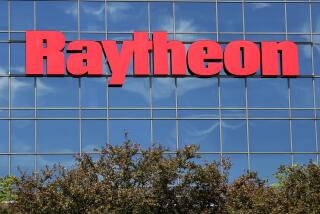Audit Raps Phoenix Missile Deals : Navy Overpaid Hughes for Work, Pentagon Report Says
- Share via
WASHINGTON — The Navy appears to have overpaid its prime contractor for the Phoenix air-to-air missile by a total of up to $27.2 million in the years 1985-86 and now is preparing to award a contract to a second manufacturer without prior testing of its version, a Pentagon audit concludes.
The missile’s developer and prime contractor is Hughes Aircraft Co., based in Los Angeles. The missiles are built in Tucson.
The Navy decided in 1984, however, to bring on a second producer and competitor for Hughes, and Raytheon Co. is now fighting for annual production work.
“We believe that the Phoenix missile program would have saved about half of its fabrication, assembly and test labor cost if an industry average realization factor would have been achieved,” the audit report states.
The audit also said the Navy could save about $35.4 million over the next three years if it would directly purchase 10 of the subcontracted components used in the missile, instead of allowing the prime contractors to buy them and add on a profit.
The audit, performed by the Defense Department’s independent inspector general, is dated Aug. 22 and focuses on $684 million worth of contracts for Phoenix missiles awarded from March, 1985, to July, 1987.
The audit bears the low-level security classification “For Official Use Only” and was not released by the Pentagon. Rather, it was disclosed Tuesday by the Project on Military Procurement, a defense watchdog group based in Washington.
The Phoenix is the Navy’s top missile for aerial dogfights. The latest model of the long-range, supersonic missile is known as the AIM-54C and is carried by the Navy’s F-14 Tomcat jet fighters.
According to the audit, the overpayments to Hughes occurred in fiscal 1985 and fiscal 1986 and probably totaled between $18.1 million and $27.2 million.
Suggests Inefficiency
The overpayments stemmed from the Navy’s willingness to allow Hughes’ production line workers more than three times as long to fabricate each missile as called for by Hughes’ own internal labor efficiency standards, the auditors wrote.
Even if industry averages were used for labor efficiency instead of internal Hughes standards, Hughes was given about twice as much time to build each missile as would normally be the case, suggesting much inefficiency, the audit said.
The audit does not suggest that the money can be recovered at this point, but does recommend that the Navy conduct an analysis of Hughes’ labor efficiency on the assembly line before awarding any more contracts.
The Navy refused in a written response, saying such an analysis wasn’t needed because future contracts would be based on competitive bidding.
The auditors countered that the Navy really wasn’t in the proper position to begin significant competitive bidding between Hughes and Raytheon, because it hasn’t conducted “verification testing of Raytheon’s missile (to) demonstrate its operational suitability.”
“The master schedule . . . shows that qualification testing and interchangeability verification of Raytheon’s missile will not be completed until March, 1990, more than 15 months after the first competitive procurement scheduled for December, 1988,” the report said.
“Raytheon could be awarded a portion of the total requirement in fiscal 1989 of 560 missiles, valued at about $483 million, before demonstrating that it can produce a qualified missile with components that can be interchanged with those of the Hughes Aircraft missile.”
The Navy replied that “the Raytheon missile design is essentially identical to the Hughes missile. . . . None of the changes proposed by Raytheon impact performance, interchangeability or interoperability.”
More to Read
Sign up for Essential California
The most important California stories and recommendations in your inbox every morning.
You may occasionally receive promotional content from the Los Angeles Times.









